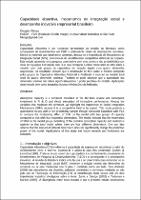| dc.contributor.author | Filenga, Douglas | |
| dc.date.accessioned | 2021-05-27T15:55:58Z | |
| dc.date.available | 2021-05-27T15:55:58Z | |
| dc.date.issued | 2013 | |
| dc.identifier.uri | https://hdl.handle.net/20.500.13048/885 | |
| dc.description.abstract | Capacidade Absortiva é um construto apresentado na revisão da literatura como consequente de investimentos em P&D e antecedente direto de desempenho inovativo. Dentre as variáveis que moderam o construto, destaca-se a importância de Mecanismos de Integração Social (MIS), pois trata-se de um diferencial competitivo difícil de ser copiado. Este estudo apresenta uma pesquisa quantitativa com uma amostra não probabilística por meio de Equações Estruturais com PLS para comparar o efeito moderador de MIS sobre o modelo com dois grupos de capacidade em relação àquele com quatro dimensões sequenciais. Os resultados indicam que a moderação de MIS sobre o modelo composto pelos grupos de Capacidade Absortiva Potencial e Realizada é superior ao modelo total onde há quatro dimensões distintas. Também se pode observar que a quantidade das dimensões internas não altera significativamente o poder preditivo do modelo. Aplicações desse estudo bem como pesquisas futuras e limitações são indicadas. | |
| dc.description.abstract | Absorptive capacity is a construct presented in the literature review and consequent
investment in R & D and direct antecedent of innovative performance. Among the
variables that moderate the construct, we highlight the importance of Social Integration
Mechanisms (SIM) because it is a competitive hard to be copied. This study presents a
quantitative survey with a non-probability sample through Structural Equations with PLS
to compare the moderating effect of SIM on the model with two groups of capacity
compared to that with four sequential dimensions. The results indicate that the moderation
of SIM on the model group consisting of the potential absorption capacity and realized is
superior to that total model where there are four different dimensions. One can also
observe that the amount of internal dimensions does not significantly change the predictive
power of the model. Applications of this study and future research and limitations are
indicated. | |
| dc.language.iso | por | |
| dc.rights | info:eu-repo/semantics/openAccess | |
| dc.rights | Atribución-NoComercial-SinDerivadas 2.5 Perú | |
| dc.rights.uri | http://creativecommons.org/licenses/by-nc-nd/2.5/pe/ | |
| dc.subject | Capacidad de absorción | |
| dc.subject | Integración social | |
| dc.subject | Desempeño empresarial | |
| dc.title | Capacidade absortiva, mecanismos de integração social e desempenho inovativo empresarial brasileiro | |
| dc.type | info:eu-repo/semantics/conferenceObject | |
| dc.relation.conferencedate | 27-31 de octubre, 2013 | |
| dc.relation.conferencename | XV Congreso Latino-Iberoamericano de Gestión Tecnológica | |
| dc.relation.conferenceplace | Porto, Portugal | |
| dc.contributor.corporatename | Fundação Getúlio Vargas | |
| dc.contributor.corporatename | Universidade Metodista de São Paulo | |


